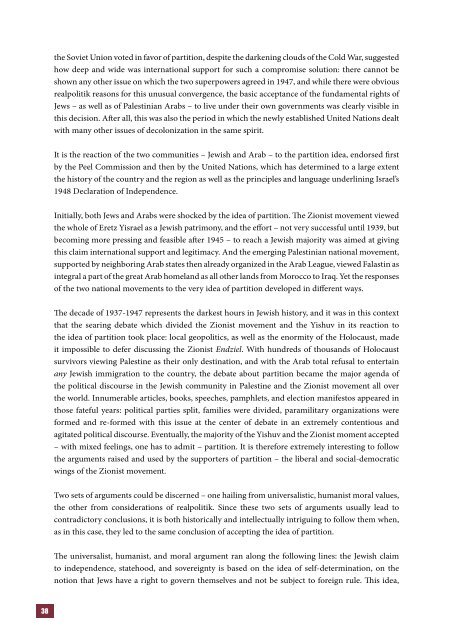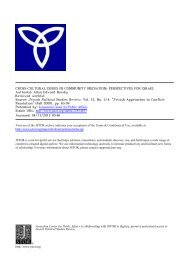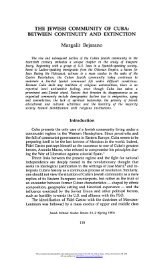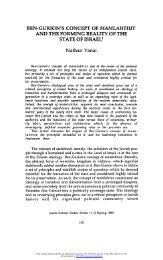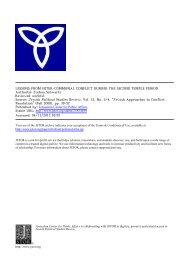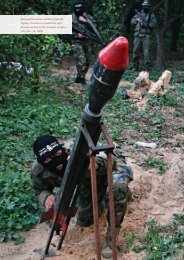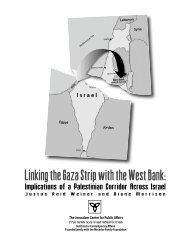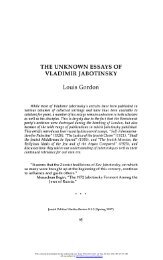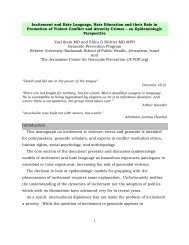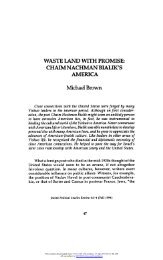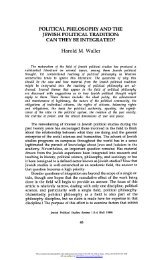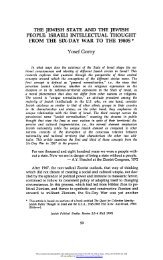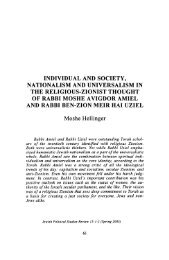Download the PDF here - Jerusalem Center For Public Affairs
Download the PDF here - Jerusalem Center For Public Affairs
Download the PDF here - Jerusalem Center For Public Affairs
- No tags were found...
You also want an ePaper? Increase the reach of your titles
YUMPU automatically turns print PDFs into web optimized ePapers that Google loves.
<strong>the</strong> Soviet Union voted in favor of partition, despite <strong>the</strong> darkening clouds of <strong>the</strong> Cold War, suggestedhow deep and wide was international support for such a compromise solution: <strong>the</strong>re cannot beshown any o<strong>the</strong>r issue on which <strong>the</strong> two superpowers agreed in 1947, and while <strong>the</strong>re were obviousrealpolitik reasons for this unusual convergence, <strong>the</strong> basic acceptance of <strong>the</strong> fundamental rights ofJews – as well as of Palestinian Arabs – to live under <strong>the</strong>ir own governments was clearly visible inthis decision. After all, this was also <strong>the</strong> period in which <strong>the</strong> newly established United Nations dealtwith many o<strong>the</strong>r issues of decolonization in <strong>the</strong> same spirit.It is <strong>the</strong> reaction of <strong>the</strong> two communities – Jewish and Arab – to <strong>the</strong> partition idea, endorsed firstby <strong>the</strong> Peel Commission and <strong>the</strong>n by <strong>the</strong> United Nations, which has determined to a large extent<strong>the</strong> history of <strong>the</strong> country and <strong>the</strong> region as well as <strong>the</strong> principles and language underlining Israel’s1948 Declaration of Independence.Initially, both Jews and Arabs were shocked by <strong>the</strong> idea of partition. The Zionist movement viewed<strong>the</strong> whole of Eretz Yisrael as a Jewish patrimony, and <strong>the</strong> effort – not very successful until 1939, butbecoming more pressing and feasible after 1945 – to reach a Jewish majority was aimed at givingthis claim international support and legitimacy. And <strong>the</strong> emerging Palestinian national movement,supported by neighboring Arab states <strong>the</strong>n already organized in <strong>the</strong> Arab League, viewed Falastin asintegral a part of <strong>the</strong> great Arab homeland as all o<strong>the</strong>r lands from Morocco to Iraq. Yet <strong>the</strong> responsesof <strong>the</strong> two national movements to <strong>the</strong> very idea of partition developed in different ways.The decade of 1937-1947 represents <strong>the</strong> darkest hours in Jewish history, and it was in this contextthat <strong>the</strong> searing debate which divided <strong>the</strong> Zionist movement and <strong>the</strong> Yishuv in its reaction to<strong>the</strong> idea of partition took place: local geopolitics, as well as <strong>the</strong> enormity of <strong>the</strong> Holocaust, madeit impossible to defer discussing <strong>the</strong> Zionist Endziel. With hundreds of thousands of Holocaustsurvivors viewing Palestine as <strong>the</strong>ir only destination, and with <strong>the</strong> Arab total refusal to entertainany Jewish immigration to <strong>the</strong> country, <strong>the</strong> debate about partition became <strong>the</strong> major agenda of<strong>the</strong> political discourse in <strong>the</strong> Jewish community in Palestine and <strong>the</strong> Zionist movement all over<strong>the</strong> world. Innumerable articles, books, speeches, pamphlets, and election manifestos appeared inthose fateful years: political parties split, families were divided, paramilitary organizations wereformed and re-formed with this issue at <strong>the</strong> center of debate in an extremely contentious andagitated political discourse. Eventually, <strong>the</strong> majority of <strong>the</strong> Yishuv and <strong>the</strong> Zionist moment accepted– with mixed feelings, one has to admit – partition. It is <strong>the</strong>refore extremely interesting to follow<strong>the</strong> arguments raised and used by <strong>the</strong> supporters of partition – <strong>the</strong> liberal and social-democraticwings of <strong>the</strong> Zionist movement.Two sets of arguments could be discerned – one hailing from universalistic, humanist moral values,<strong>the</strong> o<strong>the</strong>r from considerations of realpolitik. Since <strong>the</strong>se two sets of arguments usually lead tocontradictory conclusions, it is both historically and intellectually intriguing to follow <strong>the</strong>m when,as in this case, <strong>the</strong>y led to <strong>the</strong> same conclusion of accepting <strong>the</strong> idea of partition.The universalist, humanist, and moral argument ran along <strong>the</strong> following lines: <strong>the</strong> Jewish claimto independence, statehood, and sovereignty is based on <strong>the</strong> idea of self-determination, on <strong>the</strong>notion that Jews have a right to govern <strong>the</strong>mselves and not be subject to foreign rule. This idea,38


